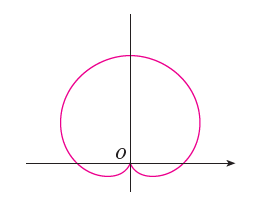Length Q[1]

The cardioid above is defined by the equation r = 1 + sin θ , where the Cartesian co-ordinates x and y define r as r = x 2 + y 2 .
Find the length of the cardioid.
The answer is 8.
This section requires Javascript.
You are seeing this because something didn't load right. We suggest you, (a) try
refreshing the page, (b) enabling javascript if it is disabled on your browser and,
finally, (c)
loading the
non-javascript version of this page
. We're sorry about the hassle.
2 solutions
Thanks for the solution :)
You are welcome
r is a vector which can be resolved into cartesian components x and y which are dependent on parameter θ .
x = r c o s ( θ ) and y = r c o s ( θ )
d θ d x = d θ d r × c o s ( θ ) − r s i n θ
d θ d y = d θ d r × s i n ( θ ) + r c o s θ
( d θ d x ) 2 + ( d θ d y ) 2 = ( d θ d r ) 2 + r 2 [1]
d x 2 + d y 2 = d L
( d θ d x × d θ ) 2 + ( d θ d y × d θ ) 2 = d L
( d θ d x ) 2 + ( d θ d y ) 2 ) × d θ = d L
From[1]
r 2 + d θ d r × d θ = d L
Taking integral of d L from θ = 0 t o 2 π gives L,length of cardioid
L = ∫ 0 2 π r 2 + d θ d r × d θ
L = ∫ 0 2 π ( 1 + s i n θ ) 2 + c o s 2 θ × d θ
L = ∫ 0 2 π 2 + 2 s i n θ × d θ = 8
The length of curve in polar coordinate from θ = 0 to 2 π is given by (see Arc Length of Polar Curves) :
s = ∫ 0 2 π r 2 + ( d θ d r ) 2 d θ = 2 ∫ − 2 π 2 π r 2 + ( d θ d r ) 2 d θ = 2 ∫ − 2 π 2 π ( 1 + sin θ ) 2 + cos 2 θ d θ = 2 ∫ − 2 π 2 π 2 + 2 sin θ d θ = 2 2 ∫ − 2 π 2 π 1 + cos ( 2 π − θ ) d θ = 2 2 ∫ − 2 π 2 π 2 cos 2 ( 4 π − 2 θ ) d θ = 4 ∫ − 2 π 2 π cos ( 4 π − 2 θ ) d θ = − 8 sin ( 4 π − 2 θ ) ∣ ∣ ∣ ∣ − 2 π 2 π = − 8 ( sin 0 − sin 2 π ) = 8 Note that the Cardioid is symmetrical about the y -axis As sin x = cos ( 2 π − x ) and cos ( 2 x ) = 2 cos 2 x − 1